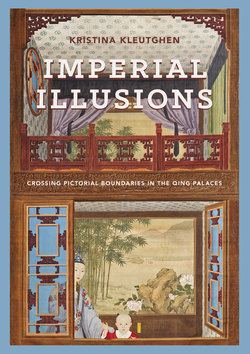Читать книгу Imperial Illusions - Kristina Kleutghen - Страница 22
На сайте Литреса книга снята с продажи.
Оглавлениеseventeenth- and eighteenth-century Chinese viewers to European art consistently demonstrate that they were able to see the illusions in those paintings, indicating the legibility of most Western pictorial depth cues in the High Qing visual world despite a painting history that did not privilege such representations. However, the act of picturing now looked different than it did before, raising the question of how Chinese visuality was also changing in response to sustained contact with European representational modes. Broadly defined as the social aspect of vision, visuality is useful as a heuristic device to investigate the relationship between vision and representation in cross-cultural contexts.25 When approached in this way, evidence demonstrates there is no single early modern visuality derived from any particular place (including Europe), and that perhaps the only shared value across early modern visuality is its willingness to engage the foreign.26 That willingness varied somewhat with class and social status in early modern China, but there is no question that Western techniques affected Chinese visuality in ways that have yet to be fully understood.
Among the depth cues found in scenic illusion paintings, the importance of linear perspective is particularly clear in Spring’s Peaceful Message. When faced with a perspectival painting, the viewer interprets apparent distance and depth through the perceived position of objects relative to the horizon line and to the apex of the visual angle (the angle at which a viewed object subtends at the eye). In other words, the closer to the horizon and visual angle, the farther away an object appears, especially when size constancy is also at work. To create the impression of a room that recedes away from the viewer, Spring’s Peaceful Message uses pavimento, a common Renaissance pictorial device in which the straight lines of a tiled or paved floor create the orthogonals of linear perspective receding to its single vanishing point. Linear perspective was entirely intelligible to Chinese viewers; however, chiaroscuro and obvious shading failed spectacularly as depth cues because of traditional Chinese aesthetics. Chinese viewers typically interpreted dark shading and sometimes even cast shadows as dirt on the surface of a painting or as indicating dirty faces and soiled clothing. Qianlong himself vehemently disliked it, thereby ensuring its near absence in scenic illusions, where light and highlight (rather than light and shadow) lend mass and volume to objects and rooms. Figures sometimes and landscapes often cleave more to Chinese than to European conventions, as is seen in the area of the Spring’s Peaceful Message presented as outside in the garden (figure I.4), where the figures are depicted with the flatter, more surface- and line-oriented aesthetics of traditional Chinese figure painting rather than the volumetric possibilities of Western painting. The unpainted background landscape, distinctive texture strokes on the rocks and tree trunks, highly stylized plant foliage, and complete lack of either cast shadows or modeling are what one would expect in a traditional Chinese landscape painting, and not in a quadratura. Nevertheless, this blend of three-dimensional European perspectival illusionism with traditional Chinese representational modes is what ultimately helps lead the viewer to recognize the scene as a painting.
